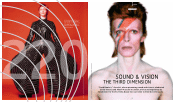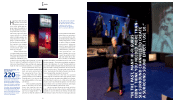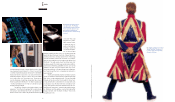Sennheiser 2012 Annual Report Download - page 19
Download and view the complete annual report
Please find page 19 of the 2012 Sennheiser annual report below. You can navigate through the pages in the report by either clicking on the pages listed below, or by using the keyword search tool below to find specific information within the annual report.
36
1,000 Hz
j U 320
There are two volume controls – one for the game
audio and one for other players – and the microphone
communicates your messages clearly and distinctly.
Sennheiser U 320 Multi-Platform Gaming Headset
Frequency response
(headphones)
15 – 23,000 Hz
Impedance 32 Ohm
Sensitivity -38d V/Pa
Weight 284 g
RACING GAME
grew up only a few miles away from the Nürburgring and
often accompanied his father, who worked there as a
medic, to the track.
Thomas Jung is the technical director of the Black
Falcon racing team and oversees world-class racing drivers
at 24-hour races. The team uses racing sims to save money,
as on-track training is an expensive business. “These days
drivers will learn new circuits in the simulator, especially
young drivers,” explains Jung. “Once they get a chance on
the real-life circuit, they practically know every single turn
already.” The rFactor racing sim, open-source software that
programmers are free to adapt and refine, is much more
than simply a game for Jung. “The game’s physics even
make it interesting to top-class motor racing teams.” One
thing Jung needs is reliable headphones: “I have to be able
to trust the headset 100 percent,” he says. “If something is
wrong in that area, then the race is lost.”
In Formula 1 – real-world F1 this time – the legend-
ary Scuderia Ferrari use Sennheiser headsets for pit team
communications. “Headsets are absolutely vital in a sport
such as motor racing,” says one Ferrari team member.
Whereas such importance is attached to a detailed depiction
of the racing environment in racing sims, the opposite is true
when it comes to communications in the pits. However, top-
quality headsets are still an absolute necessity. “When the
driver is talking to us, it’s vital that the sound is clear and not
distorted,” says Thomas Jung from the Black Falcon.
Chris Dymond is another person who blurs the lines
between simulation and real-life racing. He races in the
Porsche Carrera Cup Great Britain and the FIA GT3 European
Championship, but is also a star on iRacing online simulation.
For Dymond, the sounds of his racing car on iRacing are even
more important than when he is racing in the real world. “On
iRacing there’s no way to experience the
car’s physics,” he says. “There are no vi-
brations through your seat or the pedals.
The absence of these sensations is what
makes the sound so important.” That is
why a high-quality headset is a must. “If the sound is poor,
I make more mistakes,” he says.
However, despite the progress made in virtual racing
simulation, Dymond still believes that it’s a world away from
the true experience. Even if it becomes possible to simulate
everything perfectly in future, from the weather to the pen-
etrating smell of fuel and sweat in the driving seat, one as-
pect of real-life racing will never be able to be simulated:
“The fear of something going wrong; something that even
the top professionals cannot turn off.”
e1. Almost like training
for a space shuttle: Sim
racer Thomas Jung in a
full-motion simulator.
























